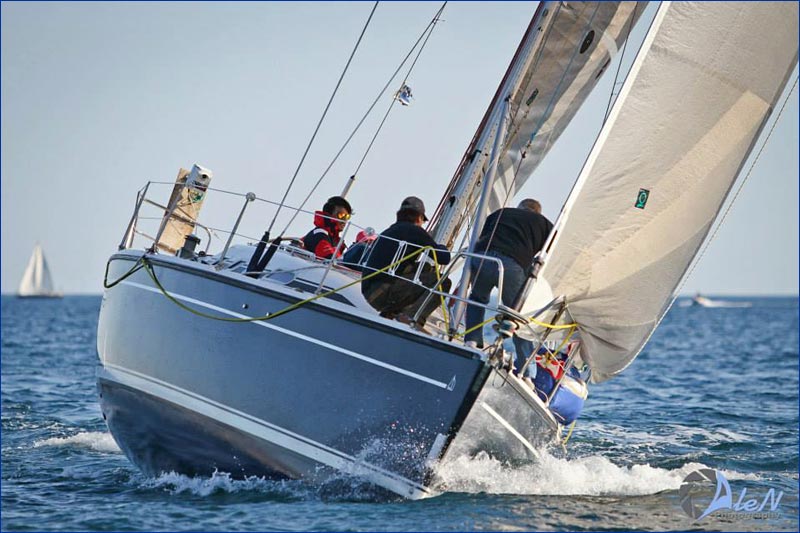Greek Islands Guide and Information for Yacht Charterers
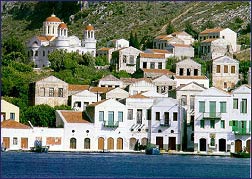
Greece and her islands have always attracted visitors drawn by the fascination with one of Europe's earliest civilizations. The majority of today's visitors are also drawn by Greece's beautiful sailing waters, friendly people, beaches and sunshine. Greece has more coastline than any other country in Europe. You can choose between rocky outcrops, pebbled coves or long swathes of golden sand.
Greece has clung to its traditions more tenaciously than most European countries.
Many traditions take the form of festivals, where Greeks express their love for life through dancing, singing and feasting. But don't think for a moment that Greece is trapped in a time warp. In towns and cities you will find discos as lively and cosmopolitan as any in Italy, France or Britain, and boutiques as trendy. Houses for sale and property in Greece are also of great interest if you are seeking a holiday home in addition to a sailing holiday.
Explore and you will discover that in addition to its outstanding beauty, Greece is one of Europe's most relaxed and friendliest countries.
THE GREEK ISLANDS
Situated at the north east of the Mediterranean is the glorious Greek archipelago. It is impressively made up over 3000 islands, of which only 140 are inhabited. Each island has its own unique style, charm and history. The stark white cubic architecture of the Cyclades is dramatically different from the Venetian architecture found in the Ionian or the Gothic seen in the Dodecanese. You will have the opportunity to sample different local specialties and wines. There is an island for everyone; whether you are seeking quiet laid back shores or lively beaches and party filled nights. Crystalline waters, steeping cliffs, hidden coves and lush forests are just part of what draws people to the Greek Islands. Come and you will experience in many places, a way of life that has endured for centuries.
| The Saronic Gulf Islands | Evia & The Sporades | Cyclades |
| Ionian Islands | Dodecanese | Northeastern Aegean |
| Crete | The Peloponnese | Athens |
THE SARONIC GULF ISLANDS
View Regional Marine Charts & Map -- Top of PageSalamina, Aegina, Poros, Hydra, Spetses
The Saronic Gulf Islands are the closest group to Athens. They are a very popular escape for Athenians.
SALAMINA
Salamina is the largest of the Saronic Gulf islands and the closest to Athens. On its western side you will find remote sandy beaches with picturesque fish tavernas.
AEGINA
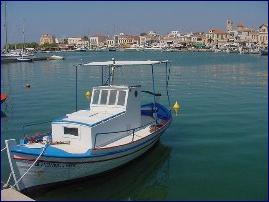 Aegina Town, on the west coast, is the island's charming and bustling, main capital and port. Its harbor is lined with colorful caiques and several of the town's crumbling neoclassic buildings survives from its days as the Greek capital.
North of Aegina Town in Livadi is the house where Nikos Kazantzakis wrote Zorba the Greek.
The splendid, well preserved Doric Temple of Aphaia, erected in 480 BC, is the major ancient site of the Saronic Gulf Islands.
The east coast town of Agia Marina is the island's premier tourist resort.
Aegina Town, on the west coast, is the island's charming and bustling, main capital and port. Its harbor is lined with colorful caiques and several of the town's crumbling neoclassic buildings survives from its days as the Greek capital.
North of Aegina Town in Livadi is the house where Nikos Kazantzakis wrote Zorba the Greek.
The splendid, well preserved Doric Temple of Aphaia, erected in 480 BC, is the major ancient site of the Saronic Gulf Islands.
The east coast town of Agia Marina is the island's premier tourist resort.
MONI & ANGISTRI ISLETS
The islets lie off the west coast of Aegina, opposite Perdika. Moni, the smaller of the two, is a 10-minute boat ride from Perdika. It is popular for its green waters, secluded coves and hidden caves.
Angistri, located three nautical miles west of Aegina, has 400 permanent residents and its seas are sparkling clean. There are dense groves of pine and lovely coves to explore. Its small harbor is located on the west side, while the eastside provides a haven "away from it all" for a peaceful private swim.
POROS
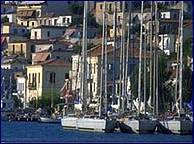 Poros was once two islands, Kalavria and Sferia. Today they are connected by a slender isthmus, cut by a canal for small boats and rejoined by a road bridge. The narrow passage of water that separates the southern tip from the Peloponnesian town of Galatas is only 360m wide at its narrowest point.
The majority of the population lives on the small volcanic islet of Sferia, where Poros Town is located. It is a pretty settlement of white houses with terracotta-tiled roofs. To the north is Kalavaria, a large well-forested island with a shoreline of 42km.
Poros was once two islands, Kalavria and Sferia. Today they are connected by a slender isthmus, cut by a canal for small boats and rejoined by a road bridge. The narrow passage of water that separates the southern tip from the Peloponnesian town of Galatas is only 360m wide at its narrowest point.
The majority of the population lives on the small volcanic islet of Sferia, where Poros Town is located. It is a pretty settlement of white houses with terracotta-tiled roofs. To the north is Kalavaria, a large well-forested island with a shoreline of 42km.
HYDRA
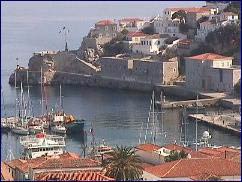 Hydra is the Saronic Gulf with the most style; it is one of Greece's most exclusive resorts. The gracious white and pastel stone mansions of Hydra Town are stacked up the rocky hillsides that surround the fine natural harbor. Hydra has no motorized transport and the town boasts a busy nightlife.
The waters of Spillia are deep and delightful as well as Mandraki Beach at Kamini and at Vlyhos. Beaches further off that can be reached with your boat are Molos and Bisti.
Hydra is the Saronic Gulf with the most style; it is one of Greece's most exclusive resorts. The gracious white and pastel stone mansions of Hydra Town are stacked up the rocky hillsides that surround the fine natural harbor. Hydra has no motorized transport and the town boasts a busy nightlife.
The waters of Spillia are deep and delightful as well as Mandraki Beach at Kamini and at Vlyhos. Beaches further off that can be reached with your boat are Molos and Bisti.
SPETSES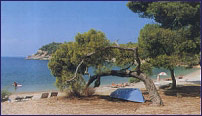 Pine covered Spetses is the most further of the group from Piraeus. Spetses Town sprawls along almost half the northeast coast of the island. The prettiest part of town is around the old harbor, which is a delightful place to explore. It is ringed by old Venetian buildings, and filled with of every shape and size. The shipbuilders of Spetses still do things the traditional way and the shore is dotted with the hulls of emerging caiques. It lies at the entrance to the Argolic Gulf.
Spetses' coastline is speckled with numerous small, pine-shaded beaches.
Beaches that can be reached by boat are Vrellas and Zogheria on the north side of the island and the pine trees grow right up to the water's edge.
The beautiful bays of Agia Paraskevi and Agioi Anargyri are on the southwestern coast.
The islet of Kounoupi is to the northeast of Spetses.
Pine covered Spetses is the most further of the group from Piraeus. Spetses Town sprawls along almost half the northeast coast of the island. The prettiest part of town is around the old harbor, which is a delightful place to explore. It is ringed by old Venetian buildings, and filled with of every shape and size. The shipbuilders of Spetses still do things the traditional way and the shore is dotted with the hulls of emerging caiques. It lies at the entrance to the Argolic Gulf.
Spetses' coastline is speckled with numerous small, pine-shaded beaches.
Beaches that can be reached by boat are Vrellas and Zogheria on the north side of the island and the pine trees grow right up to the water's edge.
The beautiful bays of Agia Paraskevi and Agioi Anargyri are on the southwestern coast.
The islet of Kounoupi is to the northeast of Spetses.
EVIA & THE SPORADES
View Regional Marine Chart & Map -- Top of PageSkiathos, Skopelos, Alonissos, Skyros
EVIA 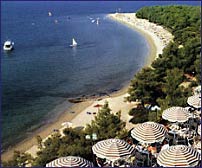 Evia is the second largest island in Greece. The narrow channel that separates it from the mainland is only 40 meters wide. The waters here travel at speeds of up to 8 miles per hour, changing direction every 6 hours.
The landscape in Evia is rich and varied with pristine inland villages and scenic mountain roads, gorgeous sandy beaches and steeping cliffs.
The picturesque town of Kymi is built on a cliff 250m above the sea. The port of Kymi (Paralia Kymis), 4km downhill is the only natural harbor on the precipitous east coast.
Set on the wide Karystian Bay below Mt Ohi (1398m) is Karystos, the most attractive of the southern Evia resorts.
Evia is the second largest island in Greece. The narrow channel that separates it from the mainland is only 40 meters wide. The waters here travel at speeds of up to 8 miles per hour, changing direction every 6 hours.
The landscape in Evia is rich and varied with pristine inland villages and scenic mountain roads, gorgeous sandy beaches and steeping cliffs.
The picturesque town of Kymi is built on a cliff 250m above the sea. The port of Kymi (Paralia Kymis), 4km downhill is the only natural harbor on the precipitous east coast.
Set on the wide Karystian Bay below Mt Ohi (1398m) is Karystos, the most attractive of the southern Evia resorts.
North of Evia is the Sporades, a group of islands of dense vegetation and mountainous terrain. Its waters are teeming with fish, the seafood is remarkable: lobster, octopus, and huge prawns often baked with cheese and fresh tomatoes. They are situated across the port town of Volos on the eastern coast of mainland Greece. Positioned at the foot of Mt Pelion on the Pagasitic Gulf, Volos is a good base for enjoying the sea, the wooded slopes and green valleys that surround it.
SKIATHOS
Much of pine covered Skiathos is blessed with exquisite beaches of golden sand. Not surprisingly it is one of Greece's premier resorts.
The island has only one settlement, the port and capital, Skiathos Town, on the southeast coast. The north coast is precipitous and less accessible. Most people come to the island for the beaches and nightlife, but the truly curious will discover some picturesque walks, hidden valleys and quiet beaches.
Skiathos town has twin harbors divided by Bourtzi islet, which is reached, by a narrow causeway.
Beaches
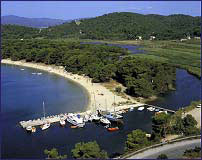 With some 65 beaches to choose from, many of which are only accessible by boat, beach hopping on Skiathos can be a fulltime occupation.
On the south coast the pine fringed, long and sandy Vromolimnos Beach, has been awarded an EU blue flag for cleanliness, while Koukounaries Beach, which is backed by pine trees and a lagoon and is touted as the best beach in Greece.
Koukounaries is a horseshoe shaped beach lined with pine trees with golden sand. In back of the pines is a gorgeous lake
Other beaches with thick pine forests and sand dunes are, Krassa (Banana Beach), Ag Elenis and Mandraki.
With some 65 beaches to choose from, many of which are only accessible by boat, beach hopping on Skiathos can be a fulltime occupation.
On the south coast the pine fringed, long and sandy Vromolimnos Beach, has been awarded an EU blue flag for cleanliness, while Koukounaries Beach, which is backed by pine trees and a lagoon and is touted as the best beach in Greece.
Koukounaries is a horseshoe shaped beach lined with pine trees with golden sand. In back of the pines is a gorgeous lake
Other beaches with thick pine forests and sand dunes are, Krassa (Banana Beach), Ag Elenis and Mandraki.
Lalaria, on the north coast, is a striking beach of pale gray pebbles, much featured in tourist brochures Sailing around the island you will find on the northport Galazia Spilia (blue cave) and nearby Skotoni Spilia (dark cave). When you become accustomed to the dark your eyes will behold a breathtaking spectacle. Opposite is Tsougria a very pretty little green island with pure white sand. You can also view Skiathos property for sale if you are interested in houses and real estate in Skiathos.
SKOPELOS
This lush green paradise is heavily pine forested, the sheltered southeast coast harbors many beaches, most of which are pebbled, while the northwest is exposed with high cliffs. It lies between Skiathos and Alonissos. The tourist development has not affected its intensely traditional character.
Skopelos Town is most captivating. It skirts a semi circular bay with dazzling white houses that and clambers in tiers up a hillside, culminating in a ruined fortress.
Beaches
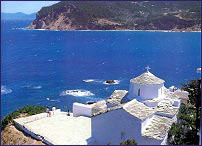 Skopelos' beaches are almost all on the sheltered southwest and west coasts. Limonari and Millia are considered the islands best. Agnontas is a leeward bay 8km out of Hora. Panoramos is the most beautiful bay on the island with a wonderful sandy beach and opposite a little green island.
Milia is the largest and most beautiful sand beach on Skopelos opposite of which is the lush islet of Dasia.You can also view Skopelos property for sale if you are interested in houses and real estate in Skopelos.
With your boat you can get to know the entire coastline, including deserted shores to the northeast and visiting Trypti cave will prove rewarding.
Other beaches include, Chysi Mila, Kokkinocastro, and Tzorti Gialos, Leptos Gialos, which have pure white sand.
Kokkinonsi a small island where finds from the Paleolithic period were discovered.
Skopelos' beaches are almost all on the sheltered southwest and west coasts. Limonari and Millia are considered the islands best. Agnontas is a leeward bay 8km out of Hora. Panoramos is the most beautiful bay on the island with a wonderful sandy beach and opposite a little green island.
Milia is the largest and most beautiful sand beach on Skopelos opposite of which is the lush islet of Dasia.You can also view Skopelos property for sale if you are interested in houses and real estate in Skopelos.
With your boat you can get to know the entire coastline, including deserted shores to the northeast and visiting Trypti cave will prove rewarding.
Other beaches include, Chysi Mila, Kokkinocastro, and Tzorti Gialos, Leptos Gialos, which have pure white sand.
Kokkinonsi a small island where finds from the Paleolithic period were discovered.
ALONNISOS
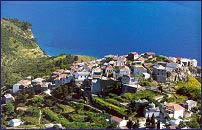 The water around this serene, green island has been declared a marine park, and is the cleanest in the Aegean. Every house has a cesspit, so no sewage enters the sea.
Old Alonnisos is a tranquil picturesque place with lovely views.
Most of the beaches are on the east coast, which means they avoid the strong summer meltemi winds. Kokkinokastro Beach was once the site of the ancient city Ikos; there are remains of the city walls and a necropolis under the sea.
The water around this serene, green island has been declared a marine park, and is the cleanest in the Aegean. Every house has a cesspit, so no sewage enters the sea.
Old Alonnisos is a tranquil picturesque place with lovely views.
Most of the beaches are on the east coast, which means they avoid the strong summer meltemi winds. Kokkinokastro Beach was once the site of the ancient city Ikos; there are remains of the city walls and a necropolis under the sea.
ISLETS AROUND ALONISSOS
Alonissos is surrounded be eight uninhabited islets.
Piperi, to the northeast of Alonissos is a refuge for the Mediterranean Monk seal (monachus monachus) and it is forbidden to set foot there.
Kyra Panagia has good beaches and two abandoned monasteries. It is the largest of the islets, with three bays, Agios Petros (sandy beaches), one to the north, with a marvelous enclosed harbor and a smaller one to the east where a 16th century monastery is.
Psathoura has the submerged remains of an ancient city and the brightest lighthouse in the Aegean
Peristera has several sandy beaches and the remains of a castle.
Other islets include: Pappous, Skantzoura, Psathouropoud, Gioura, Adephi.
SKYROS
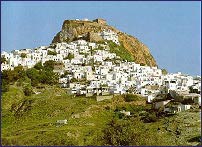 Skyros is some distance from the rest of the group; it also has a different atmosphere, reminding you more of the Cyclades than the Sporades.
Skyros Town is a striking, dazzling white town of flat-roofed Cycladic style houses draped over a high rocky bluff.
The resort of Magazia is at the southern end of a splendid, long sandy beach; Molos is at the northern end of the beach.
Beaches
At Atsitsa, on the west coast, there is a tranquil pebble beach shaded by pines. To the north is the even less crowded beach of Kyra Panagia. At Pefkos there is another good but small beach and taverna.
Farther east is the pebble and sand beach at Kalamitsa. Opposite, are the small, uninhabited islets of Valaxa and Skyropoulo.
Skyros is some distance from the rest of the group; it also has a different atmosphere, reminding you more of the Cyclades than the Sporades.
Skyros Town is a striking, dazzling white town of flat-roofed Cycladic style houses draped over a high rocky bluff.
The resort of Magazia is at the southern end of a splendid, long sandy beach; Molos is at the northern end of the beach.
Beaches
At Atsitsa, on the west coast, there is a tranquil pebble beach shaded by pines. To the north is the even less crowded beach of Kyra Panagia. At Pefkos there is another good but small beach and taverna.
Farther east is the pebble and sand beach at Kalamitsa. Opposite, are the small, uninhabited islets of Valaxa and Skyropoulo.
CYCLADES ISLANDS
View Regional Marine Chart & Map -- Top of PageKea, Kythnos, Serifos, Sifnos, Milos, Kimolos, Skiathos, Andros, Tinos, Mykonos, Delos, Paros, Antiparos, Naxos, Ios, Amorgos, Santorini, Anafi, Folegandros, Sikinos, Skiathos
The Cyclades are the quintessential Greek islands- rocky outcrops accented with dazzling white buildings offset by bright blue church domes, all showered in radiant light and fringed with golden beaches lapped by aquamarine seas.
According to mythology all the islands form an invisible circle (kyklos) around the island of Delos, which was considered sacred as the land of Apollo, god of light.
The islands are small and closely grouped making them ideal for island hopping.
KEA
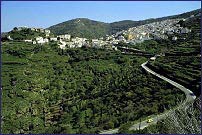 Kea is the closest of the Cyclades to the mainland, it has a shoreline of 81km.
While it appears barren from a distance, the bare hills hide fertile valleys filled with orchards and olive groves.
Kea is the closest of the Cyclades to the mainland, it has a shoreline of 81km.
While it appears barren from a distance, the bare hills hide fertile valleys filled with orchards and olive groves.
The main settlements are the port of Korissia, set on a large bay with a sandy beach and the capital, Ioulida, which is a pleasant hillside town, full of alleyways and winding steps.
Around Kea
The island's best beach Pisses is a long sandy cove backed by a green valley of orchards and olive groves.
Koundouros, lies on a bay of crystal clear water, while the sandy beach at Poles sits on the ancient site of Karthea on the southeastern side of the island.
Vourkari, a popular stop for yachts, is a trendy resort filled with lovely shops. .
Otzias is a picturesque village enclosed in a cove.You can also view Kea property for sale if you are interested in houses and real estate in Kea.
KYTHNOS
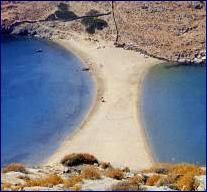 52 nautical miles from Piraeus
52 nautical miles from Piraeus
Kythnos is extremely popular with Athenian holidaymakers. The villages, Hora and Dryopida are typically Cycladic with their winding streets and windmills. There are a number of pretty little bays all along the coastline. On the northeastern side of the island lies Loutra, a popular summer spot renowned for its thermal springs.
The best beaches are on the southeastern coast, near the village of Kanala. Below the monastery Panagia Knanlia There are also several sandy beaches located north and south of Merihas, such as Episkopi and Apokrousi and Flambouria
SERIFOS
70 nautical miles from Piraeus
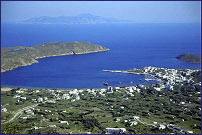 From afar, the island of Serifos appears like a great rock rising out of the sea.
Clinging on the hillside above the main port, Livadi, is the dazzling whitewashed capital Hora, it is one of the most striking Cycladic capitals.
From afar, the island of Serifos appears like a great rock rising out of the sea.
Clinging on the hillside above the main port, Livadi, is the dazzling whitewashed capital Hora, it is one of the most striking Cycladic capitals.
There are several good beaches to visit, such as the tamarisk-fringed beach at Livadakia, Karavi, which is the unofficial nudist beach and Lia.
Psili Ammos and the sheltered bay of Agios Sostis, are also good choices.
Norheast of the island is uninhabited islet of Serfopoula.
SIFNOS
78 nautical miles from Piraeus
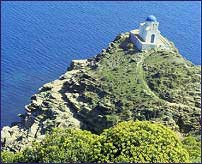 At first glance it looks deceptively barren, but once you explore, you'll find an abundantly attractive and fertile landscape, Sifniot olive oil is one of the best in Greece. Local specialties include revithia (baked chickpeas), revithokeftedes (vegetable balls), xynomyzithra (a sharpish cheese) and almond sweets.
As well as shopping for fine ceramics and jewellery, you can also find beautiful hand-woven textiles.
The capital, Apollonia, is a lovely whitewashed village set on a plateau 5km up from the port of Kamares.
3km from Apollonia is the walled cliff-top village of Kastro, it is a magical place of buttressed alleys and whitewashed houses.
At first glance it looks deceptively barren, but once you explore, you'll find an abundantly attractive and fertile landscape, Sifniot olive oil is one of the best in Greece. Local specialties include revithia (baked chickpeas), revithokeftedes (vegetable balls), xynomyzithra (a sharpish cheese) and almond sweets.
As well as shopping for fine ceramics and jewellery, you can also find beautiful hand-woven textiles.
The capital, Apollonia, is a lovely whitewashed village set on a plateau 5km up from the port of Kamares.
3km from Apollonia is the walled cliff-top village of Kastro, it is a magical place of buttressed alleys and whitewashed houses.
Around Sifnos
The resort of Platys Gialos has a long sandy beach, nearby is the spectacularly situated Moni Hrysopigilis. A path from the monastery leads to a beach with a taverna.
Vathi, on the west coast, is a gorgeous sandy bay. Faros is a cozy little fishing hamlet with a couple of nice beaches.
MILOS & KIMOLOS
78 nautical miles from Piraeus
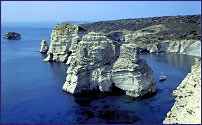 Volcanic Milos is the most westerly island of the Cyclades. It has a coastline of 125km.
Klima is a charming, unspoilt fishing village skirting a narrow beach below the settlement of Trypiti. Nearby you will discover Greece's only Christian catacombs.
A sail around the island allows you to visit most of Milos' stunning beaches (many inaccessible by road), coves and geologically interesting places.
Volcanic Milos is the most westerly island of the Cyclades. It has a coastline of 125km.
Klima is a charming, unspoilt fishing village skirting a narrow beach below the settlement of Trypiti. Nearby you will discover Greece's only Christian catacombs.
A sail around the island allows you to visit most of Milos' stunning beaches (many inaccessible by road), coves and geologically interesting places.
There are also a number of sea caves, such as Papafranga and Sykia.
Northwest of Milos is the uninhabited islet of Antimilo. Upon entering Milos bay you can't miss the impressive rocky islets of Akradies.
KIMOLOS
This small island lies just half a mile northeast of Milos. In spite of the close proximity, it does not attract many tourists.
From the port of Psathi you can sail to Kafto Beach to visit the underwater ruins of the ancient city. In the center of the island is the 364m-high cliff on which sits the fortress of Paleokastro.
ANDROS
89 nautical miles from Piraeus
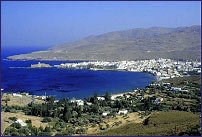 Andros is the northernmost island of the Cyclades. It is the second largest after Naxos with a coastline of 177km. It is also one of the most fertile and forested islands in the Cyclades. There is an abundance of water, Andros is renowned for its water, which is bottled at Sariza. Many of the old windmills are now being restored.
Andros is the northernmost island of the Cyclades. It is the second largest after Naxos with a coastline of 177km. It is also one of the most fertile and forested islands in the Cyclades. There is an abundance of water, Andros is renowned for its water, which is bottled at Sariza. Many of the old windmills are now being restored.
Set dramatically along a narrow peninsula on the east coast lies enchanting Hora.
It has two outstanding museums, the archaeological and the museum of modern art.
There is also a nautical museum.
On the west coast between the main port, Gavrio and Paleopolis Bay are several nice beaches: Agios Kyprianos (where a former church is now a beach front taverna), Delavoia (nudist), Green Beach and Anerousa.
If you sail around the island there is Nimborio, Gialia, and Paraporti Beach, which are near Hora.
The pretty emerald bay and holiday hamlet at Ormos Korthiou, in the southeast, has a lot of old charm.
Near Sineti, the wild Dipotamata Gorge and its water mills are now EU protected.
One of the most beautiful isolated spots Andros is Pidima tis Grias bay. You can also view Andros property for sale if you are interested in houses and real estate in Andros.
TINOS
86 nautical miles from Piraeus
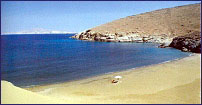 Tinos is green and mountainous like nearby Andros with a coastline of 106km. The island is a Greek Orthodox place of pilgrimage. Dominating over the capital, Hora, is the celebrated Church of Panagia Evangelistra, while unspoilt hill villages and ornate dovecotes are rural attractions.
Pyrgos is a picturesque village where marble is still carved. There is a sculpture school and several workshops where traditional items such as lintels and plaques can be purchased.
The island has a number of beautiful beaches to visit such as Porto (6km east of Hora) and Kolymvythra Bay, which has two superb sandy beaches.
Tinos is green and mountainous like nearby Andros with a coastline of 106km. The island is a Greek Orthodox place of pilgrimage. Dominating over the capital, Hora, is the celebrated Church of Panagia Evangelistra, while unspoilt hill villages and ornate dovecotes are rural attractions.
Pyrgos is a picturesque village where marble is still carved. There is a sculpture school and several workshops where traditional items such as lintels and plaques can be purchased.
The island has a number of beautiful beaches to visit such as Porto (6km east of Hora) and Kolymvythra Bay, which has two superb sandy beaches.
MYKONOS
94 nautical miles from Piraeus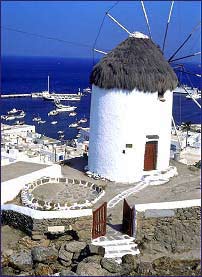
Mykonos is perhaps the most visited of all Greek islands. It has by far the most sophisticated and exciting nightlife in Greece.
Whitewashed Hora, the islands main port is a labyrinth of winding cobbled stoned alleys. Despite the throngs of people, it is most beautiful. The waterfront is filled with colorful fishing boats (caiques), and windmills spot the surrounding hilltops.
There are five museums to visit: the archaeological, the folklore, the Aegean Maritime, the windmill, and Lena's house (19th century Mykonian house with furnishings).
The Panagia Paraportiani is the most famous of Mykonos' several hundred churches. It is actually four little churches united into one beautiful white, knobby, asymmetrical structure. It is a photographer's dream
Beaches.You can also view Mykonos property for sale if you are interested in houses and real estate in Mykonos.
To the south beyond Ornos, is Agios Ioannis and to the east is Psarou, a lovely little cove.
The islands best beaches are further around the south coast: Paradise, Super Paradise, Agrari and Elia. Nudism is accepted on all these beaches. Elia is the least crowded.
North coast beaches are exposed to the meltemi winds, but Panormos and Agios Sostis are sheltered and uncrowded.
Dragonisi is an uninhabited islet east of Mykonos.
DELOS
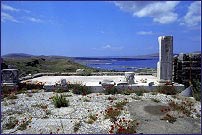 Lying a few kilometers off the west coast of Mykonos is Delos, one of the most important archaeological sites in Greece. This sacred, barren island is the mythical birthplace of Apollo and Artemis. In the 8th century BC, a festival in honor of Apollo was established; the oldest temples and shrines date from this era. But Delos did not reach the height of its power until the Hellenistic period, becoming one of the three most important religious and commercial centers in Greece. It was populated with wealthy merchants, mariners and bankers from as far away as Egypt and Syria. Although Apollo was the principle deity these inhabitants erected temples to the various gods revered in their native lands.
Exploring the Site
Lying a few kilometers off the west coast of Mykonos is Delos, one of the most important archaeological sites in Greece. This sacred, barren island is the mythical birthplace of Apollo and Artemis. In the 8th century BC, a festival in honor of Apollo was established; the oldest temples and shrines date from this era. But Delos did not reach the height of its power until the Hellenistic period, becoming one of the three most important religious and commercial centers in Greece. It was populated with wealthy merchants, mariners and bankers from as far away as Egypt and Syria. Although Apollo was the principle deity these inhabitants erected temples to the various gods revered in their native lands.
Exploring the Site
1. The Theatre Quarter, where Delos' wealthiest inhabitants built their lavish houses.
2. The theatre (300 BC)
3. The Sanctuary of Apollo contains temples dedicated to him.
4. Terrace of the Lions
5. Harbor Quarter
6. The Sanctuaries of the Foreign Gods
7. Sacred Mt Kynthos (113m)
8. The Sacred Lake
SYROS
83 nautical miles from Piraeus
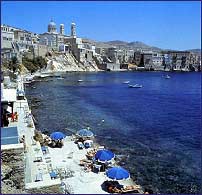 The capital of Syros is Ermoupolis, an affluent, lively town of elegant neoclassical mansions, squares, marble paved streets and chic boutiques. As your boat sails into the harbor you will catch a glimpse of the Catholic settlement of Ano Syros to the left, and the Orthodox settlement of Vrodado to the right, both situated on hills with Ermoupolis spilling down to the harbor, it is an impressive sight.
Ano Syros is a medieval settlement with narrow alleyways and whitewashed houses. It is a fascinating place to visit.
The capital of Syros is Ermoupolis, an affluent, lively town of elegant neoclassical mansions, squares, marble paved streets and chic boutiques. As your boat sails into the harbor you will catch a glimpse of the Catholic settlement of Ano Syros to the left, and the Orthodox settlement of Vrodado to the right, both situated on hills with Ermoupolis spilling down to the harbor, it is an impressive sight.
Ano Syros is a medieval settlement with narrow alleyways and whitewashed houses. It is a fascinating place to visit.
Beaches
The west coast resort of Galissas has one of the island's finest beaches: a 900m crescent of sand, shaded by tamarisk trees.
South of Galissas is Finikas with a lovely tree-lined beach and Posidonia which has a shaded sand and pebbled beach and Agathopes.
The tranquil Megas Gialoson on the south coast has two sand beaches.
PAROS & ANTIPAROS
95 nautical miles from Piraeus
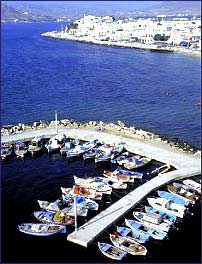 Paros is an attractive island of terraced hills, whitewashed settlements and windmills. It is the center of the Cyclades. The island's busy capital and port is Parikia, a charming, typically Cycladic old town with a 13th century Venetian kastro.
Paros is an attractive island of terraced hills, whitewashed settlements and windmills. It is the center of the Cyclades. The island's busy capital and port is Parikia, a charming, typically Cycladic old town with a 13th century Venetian kastro.
The Pangia Ekatontapyliani church, which dates from 326 AD is one of the most splendid in the Cyclades.
Naoussa, on the north coast is a popular resort at the heart of which is a colorful fishing village. Although it has an up market feel to it Naoussa is still a working harbor with piles of fishing nets, bright caiques, and little ouzeria. It is a relaxed, picturesque village with whitewashed alleyways.
There are a number a good beaches close-by, the best are Kolimvythres, Monastiri, and Santa Maria.
Lefkes, 12km southeast of Parikia, is the island's highest and loveliest village.
In July and August Petaloudes is almost enshrouded in butterflies, the sight is spectacular. You can also view Paros property for sale if you are interested in houses and real estate in Paros.
Other beaches worth visiting are Piso Livadi, Krios and Hrysi Akti.
Opposite from Dryos is the tiny islet Dryonis, which is fantastic for fishing.
ANTIPAROS
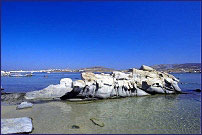 This small islands lies off the southwest coast of Paros, it has a coastline of 56 km. The main village, Antiparos is an attractive and charming port.
The Cave of Antiparos is an awe-inspiring site. At the entrance is a small chapel dedicated to St John from here the steps descend deep into the stalactite and stalagmite filled cave.
There are a number of good beaches to visit: Psaslyki, Sifnakos Gialos, Agios Gialos and Strongyle.
The small islets, which surround the Antiparos have formed narrow straits between them.
This small islands lies off the southwest coast of Paros, it has a coastline of 56 km. The main village, Antiparos is an attractive and charming port.
The Cave of Antiparos is an awe-inspiring site. At the entrance is a small chapel dedicated to St John from here the steps descend deep into the stalactite and stalagmite filled cave.
There are a number of good beaches to visit: Psaslyki, Sifnakos Gialos, Agios Gialos and Strongyle.
The small islets, which surround the Antiparos have formed narrow straits between them.
NAXOS
103 nautical miles from Piraeus
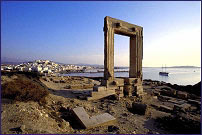 Naxos is the largest of the Cyclades. Its rugged mountains and fertile green valleys also make it one of the most beautiful. Mt Zeus (1004m) is the archipelago's highest peak. It was a prominent Byzantine center with over 500 churches and monasteries.
Naxos is the largest of the Cyclades. Its rugged mountains and fertile green valleys also make it one of the most beautiful. Mt Zeus (1004m) is the archipelago's highest peak. It was a prominent Byzantine center with over 500 churches and monasteries.
Hora is the island's capital and port. The most alluring part of Hora is Kastro, with its winding alleyways and whitewashed houses. There are also some handsome Venetian dwellings. It has a medieval atmosphere.
A causeway to the north of the port leads to the islet of Palatia and the unfinished Temple of Apollo.
The lovely Tragaea region is a vast plain of olive groves and unspoilt villages harboring numerous little Byzantine churches.
BeachesYou can also view Naxos property for sale if you are interested in houses and real estate in Naxos.
Agios Georgios is a resort town with golden sands and shallow waters. The next beach south is Agios Prokopios, a sheltered bay, followed by Agia Anna, a lovely beach of fine sand. Sandy beaches continue as far down as Pyrgaki.
Plaka is one of the island's most beautiful beaches, it is mainly nudist.
Mikri Vigla and Kastraki are also worth mentioning.
IOS
107 nautical miles from Piraeus
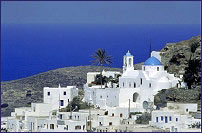 There is no denying that most visitors flock to Ios to party hard, but for those seeking relaxation, Ios has plenty to offer amongst its beautiful beaches and charming capital, Hora.
Hora is a lovely Cycladic village with narrow whitewashed laneways and houses. At night the tiny central square is transformed into a crowded open-air party.
Apart from the nightlife, the beaches are what lure travelers to Ios.
Competing with Milopotas for the best beach is Manganari, which has a long swathe of fine white sand. Nearby, Kolitzani Beach and Tsamaria are also nice.
Agio Theodoti, Psathi and Kalamos beaches, all on the northeast coast, are more remote.
There is no denying that most visitors flock to Ios to party hard, but for those seeking relaxation, Ios has plenty to offer amongst its beautiful beaches and charming capital, Hora.
Hora is a lovely Cycladic village with narrow whitewashed laneways and houses. At night the tiny central square is transformed into a crowded open-air party.
Apart from the nightlife, the beaches are what lure travelers to Ios.
Competing with Milopotas for the best beach is Manganari, which has a long swathe of fine white sand. Nearby, Kolitzani Beach and Tsamaria are also nice.
Agio Theodoti, Psathi and Kalamos beaches, all on the northeast coast, are more remote.
LITTLE CYCLADES
View Regional Marine Chart & Map -- Top of Page
The Little Cyclades is a chain of small islands between Naxos and Amorgos. Only four have permanent populations: Donousa, Koufonisia, Iraklia and Shinousa. They attract a few tourists looking for splendid beaches and a laid back atmosphere.
Donousa the northernmost of the group and the farthest from Naxos, was the site of numerous archeological finds. The others are clustered three nautical miles south of Naxos.
Sailing from island to island will prove to be a special adventure.
IRAKLIA 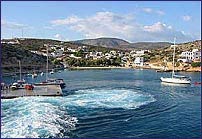
The port and main village is Agios Georgios, which has a pretty, deep cove like harbor. There is a nice beach, Livadi and a cave with fine stalactites.
SHINOUSA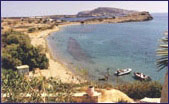
Shinousa is a wonderful little island with a lively hora and friendly residents. The hora has vast views of the sea and neighboring islands. Around the island there are several fine bays and sandy beaches, such as Tsigouri and Psili Ammos.
KOUFONISIA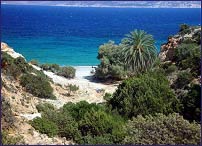
Koufonisia is really two islands, Ano Koufonisia and Kato Koufonisia, but only the latter is permanently inhabited. Although it is the smallest of the Little Cyclades, it is the most densely populated. The island has the largest fishing fleet in Greece, every family is involved with the trade. The residents are very hospitable.
The beaches are outstanding: low-lying white sand dunes, covered with wild flowers and rocky coves.
DONOUSA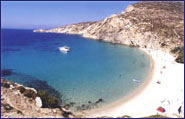
Danousa is the most remote the group. It has 130 inhabitants. Agios Stavros is the main settlement and port. Kendros is a lovely, sandy and secluded beach.
AMORGOS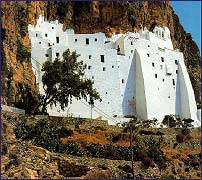
138 nautical miles from Piraeus
Amorgos is the most easterly of the Cyclades, it is most enticing. Katapola the main port is a pretty town on a large dramatic bay. The village of Hora is an impressive sight. Rising 400m above sea level, shrouded in clouds, all white and capped with a 13th century kastro atop a large rock. Down the steep hillside from Hora is the 11th century Moni Hozoviotissis, clinging precariously to a cliff face above the coast. Aegiali is Amorgos' other port. It is more laid back than Katapola, with a lovely stretch of beach.
SANTORINI (THIRA)
130 nautical miles from Piraeus
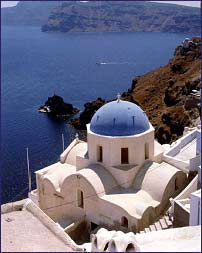 Santorini, the southern most island of the Cyclades, is thought of by many as the most spectacular of the Greek islands. The submerged caldera (crater) is a vestige of what was most likely one of the most catastrophic volcanic eruptions in recorded history.
Tourism has not diminished the dramatic atmosphere of Fira. Terraced into the volcanic cliffs are barrel-roofed cave houses and domed churches. Along the lip of the caldera are several bars and restaurants, the view of the cliffs and their multicolored layers of lava and pumice, from here is breathtaking. Ships berth at Athinios, a tiny haven beneath the towering volcanic cliffs. In favorable weather, ships anchor offshore below Fira, whose dazzling white houses and domes extend along the cliff top nearly 210m above. Further north, the village of Oia is also set on the steep slope of the caldera, many of its whitewashed buildings nestle in recesses in the volcanic rock. It is famous for its spectacular sunsets. The tiny port, Ammoudi lays 300 steps below Oia, it's a lovely spot for a swim and a bite to eat. You can also view Santorini property for sale if you are interested in houses and real estate in Santorini.
There are five commercial wineries to visit, they host tastings in the summer. The potent Santorini wine has a great reputation.
Santorini, the southern most island of the Cyclades, is thought of by many as the most spectacular of the Greek islands. The submerged caldera (crater) is a vestige of what was most likely one of the most catastrophic volcanic eruptions in recorded history.
Tourism has not diminished the dramatic atmosphere of Fira. Terraced into the volcanic cliffs are barrel-roofed cave houses and domed churches. Along the lip of the caldera are several bars and restaurants, the view of the cliffs and their multicolored layers of lava and pumice, from here is breathtaking. Ships berth at Athinios, a tiny haven beneath the towering volcanic cliffs. In favorable weather, ships anchor offshore below Fira, whose dazzling white houses and domes extend along the cliff top nearly 210m above. Further north, the village of Oia is also set on the steep slope of the caldera, many of its whitewashed buildings nestle in recesses in the volcanic rock. It is famous for its spectacular sunsets. The tiny port, Ammoudi lays 300 steps below Oia, it's a lovely spot for a swim and a bite to eat. You can also view Santorini property for sale if you are interested in houses and real estate in Santorini.
There are five commercial wineries to visit, they host tastings in the summer. The potent Santorini wine has a great reputation.
Ancient Akrotiri was a Minoan settlement, with buildings dating to the 16th century BC. Excavations started in 1967, have unearthed an ancient city beneath the volcanic ash. The site is defiantly worth a visit.
Beaches Santorini's black sand beaches are beautiful but very hot. The nicest beaches are on the east coast, such as Perivolos, Perissa and Agios Georgios. The Mediterranean Dive Club in Perissa, offers volcanic and wreck dives. There is also Kamari, Monolithos Beach and Red Beach.
THIRASIA & VOLCANIC ISLETS
Charming Thirasia was separated from Santorini by an eruption in236 BC. The hora, Manolas, is a lovely, unspoilt village perched on the cliff. To reach it, one must climb the145 steps from the harbor.
The volcanic islets of Palia Kameni and Naea Kameni are still active, they are good for a day excursion.
ANAFI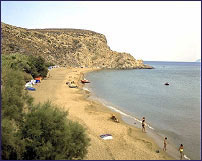
12 nautical miles from Santorini
Small, charming Anafi is where you go to enjoy the beaches and the slow paced traditional life. It's an ideal place to relax. The main town, Hora lies 2km up from the island's little port Agios Nikolas. Whitewashed dwellings and windmills nestle against the hillside. There are several lovely beaches to visit, such as palm lined Klissidi. Islets around Anafi are: Pacheia, Marra and Anydros
SIKINOS
113 nautical miles from Piraeus
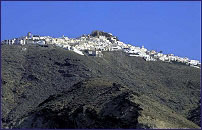 The only settlements in tranquil Sikinos are the port of Alpronia and the hilltop villages Hora and Kastro, which together form the capital. Kastro is a charming, little village with lovely old homes and hospitable locals.
The only settlements in tranquil Sikinos are the port of Alpronia and the hilltop villages Hora and Kastro, which together form the capital. Kastro is a charming, little village with lovely old homes and hospitable locals.
Many of the beaches are only accessible by boat, such as Agios Georgios, Malta (with ancient ruins on the hill above), Karra. Katergo and Agios Nikolaos Beach are in walking distance to Alopronia.
FOLEGANDROS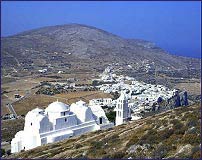
106 nautical miles from Piraeus
Most visitors come to peaceful Folegandros for the unspoilt island life. Boats dock in the small harbor of Karavostasis on the east coast. Hora, the hidden cliff top village is perhaps the most beautiful capital in the Cyclades. The medieval kastro and the maze of narrow whitewashed streets and low archways date back to the 13th century. Bougainvillea cascade down the house's wooden balconies. There are several good beaches to visit such as Agnali Beach, Agios Nikolaos, Livadaki and Agios Georgios.
IONIAN ISLANDS
View Regional Marine Chart & Map -- Top of PageCorfu, Paxi & Antipaxi, Lefkada, Ithaca, Kefallonia, Zakynthos, Kythira
The Ionian group is situated off the west coast of mainland Greece, but it is more reminiscent of Corfu's neighbor Italy. Because of the high amount of rainfall it receives, the vegetation is lusher than on the other islands. Each of the islands has it's own unique culture and cuisine.
CORFU
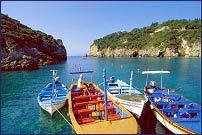 Corfu's close proximity to Italy has played a great role in its development. It is the northern most island in the Ionian group, with a coastline of 217km, and the greenest. With its luxuriant landscape of scented wild flowers and cypress trees, Corfu is thought by many as Greece's most beautiful island.
Corfu's close proximity to Italy has played a great role in its development. It is the northern most island in the Ionian group, with a coastline of 217km, and the greenest. With its luxuriant landscape of scented wild flowers and cypress trees, Corfu is thought by many as Greece's most beautiful island.
The islands capital, Corfu Town is a melange of foreign influences. Constructed during the French occupation, the Liston, a string of arcaded buildings was modeled on Paris' Rue de Rivoli. The enchanting old town with its two Venetian Fortresses is more reminiscent of Venice or Naples than Greece.
The gardened Spianada boasts Greece's only cricket grounds, a remnant of the British occupation.
Moving north from Pyrgi you will encounter some of Corfu's most captivating scenery. You can also view Corfu property for sale if you are interested in houses and real estate in Corfu.
Corfu's best beaches are on the west coast, there are several to choose from. Paleokastritsa is the coast's largest resort. Bordered by emerald waters, with sandy and pebbled coves and a green mountain backdrop, Paleokastritsa is beautiful.
The long stretch of inviting sand and dunes between Lake Korission (freshwater) and Issos is one of the least spoilt stretches of Corfu's coast.
THE DIAPONDIA ISLANDS
Ereikousa, Mathraki, and Othoni
Situated only 3-7 nautical miles from Corfu but often isolated by tricky seas, these cluster of little known islands are worth the extra effort to visit.
PAXI & ANTIPAXI
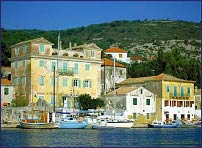 Paxos, the smallest of the Ionian group, is but 10km in length and 4km wide. It has an enchanting terrain of twisted, ancient olive grooves. People who come are drawn to its quiet shores and cozy harbors.
Set on a broad bay is the capital Gaios with its pink, cream and whitewashed red-tiled buildings, it is s lovely sight. At the entrance of the bay lies Moni Panagias Islet, named after its monastery, and almost filling the harbor is Agios Nikolaos Islet, which has a Venetian Castle and a windmill.
On the north coast, situated on a deep narrow bay is the pretty harbor of Lakka, it is a popular yachtie destination.
Paxos, the smallest of the Ionian group, is but 10km in length and 4km wide. It has an enchanting terrain of twisted, ancient olive grooves. People who come are drawn to its quiet shores and cozy harbors.
Set on a broad bay is the capital Gaios with its pink, cream and whitewashed red-tiled buildings, it is s lovely sight. At the entrance of the bay lies Moni Panagias Islet, named after its monastery, and almost filling the harbor is Agios Nikolaos Islet, which has a Venetian Castle and a windmill.
On the north coast, situated on a deep narrow bay is the pretty harbor of Lakka, it is a popular yachtie destination.
Paxis's tranquil east coast has small pebble beaches, while the west coast has awe-inspiring views of steep cliffs, and marine caves only accessible by boat.
ANTIPAXI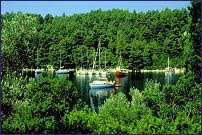
The tiny island paradise of Antipaxi lays 2km south of Paxi, it is only 5sq km. Excellent wine is produced from the grape vines that blanket the island.
Voutoumi Beach is very lovely, there is a taverna high on the cliffs above. Sandy Vrika Beach at the northeastern tip also has two tavernas.
LEFKADA
The 25m strait separating Lefkada from the mainland is spanned by a causeway. It is a mountainous island of dense forests and olive groves.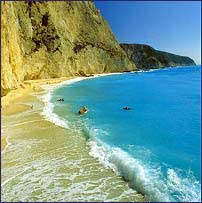 Set on a headland of a salt lagoon is the island's capital Lefkada Town, it is mainly a yacht port. Beyond the windmills, west of the lagoon is Agios Ioannis Beach, the sunsets from here are remarkable.
With both pebbled and sand beaches, the lovely fishing village of Vasiliki is supposedly the best windsurfing spot in Europe. From here you can sail to the best sand beaches on the west coast, which include Egremini, Kathisma, Porto Katsiki and Agiofylli Beach.
Set on a headland of a salt lagoon is the island's capital Lefkada Town, it is mainly a yacht port. Beyond the windmills, west of the lagoon is Agios Ioannis Beach, the sunsets from here are remarkable.
With both pebbled and sand beaches, the lovely fishing village of Vasiliki is supposedly the best windsurfing spot in Europe. From here you can sail to the best sand beaches on the west coast, which include Egremini, Kathisma, Porto Katsiki and Agiofylli Beach.
Maganisi and Kalamos are amongst the largest of Lefkada's 10 satellite islets.
With its lush landscape and emerald waters, the quiet islet of Meganisi is a popular yachting destination. It has only three settlements: the port of Vathy, Katomeri and the charming capital, Spartohori.You can also view Lefkada property for sale if you are interested in houses and real estate in Lefkada.
The forested, alpine islet of Kalamos is gorgeous. Again a more popular destination with yachters.
ITHAKI (ITHACA)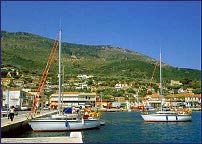
Separated from Kefallonia by only 2 to 4km Ithaki is an unspoilt island with green mountains and deep emerald bays. The bold outline of the cliffs is impressive. The coast is indented by numerous small harbors and creeks. Ancient Ithaca has been inhabited since the 3rd century BC, it was the long lost home of the mythical hero Odysseus.
Vathy, the main harbor and capital, is a small town of twisting streets and lovely cafes and tavernas.
Descending down the lush mountainside into a charming little harbor is the small fishing village of Kioni. It is a very popular yachting destination.
The best beaches lie on the stretch of coast between Kioni and Frikes.
KEFALONIA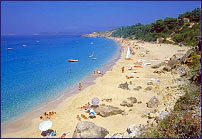 As you sail towards Kefalonia, the largest of the Ionian Islands, you will see Mt Enos (1520m) towering in the distance. Characteristic features of the beautiful landscape are the noble fir forests; the currant vineyards; the olive groves; and wild flowers from which perfumes are made. The local wines are excellent.
The capital of the island is lively Argostoli. Its delightfully situated some way up the gulf of Argostoli in a inlet so shallow that a British built causeway was constructed in 1813, to connect it with the rest of Kefalonia.You can also view Kefalonia property for sale if you are interested in houses and real estate in Kefalonia.
2.5km from the island's main port, Sami, is Melisani Cave, a subterranean sea-lake. Drogarati Cave has spectacular stalactites. KTEL organizes tours to both sites.
As you sail towards Kefalonia, the largest of the Ionian Islands, you will see Mt Enos (1520m) towering in the distance. Characteristic features of the beautiful landscape are the noble fir forests; the currant vineyards; the olive groves; and wild flowers from which perfumes are made. The local wines are excellent.
The capital of the island is lively Argostoli. Its delightfully situated some way up the gulf of Argostoli in a inlet so shallow that a British built causeway was constructed in 1813, to connect it with the rest of Kefalonia.You can also view Kefalonia property for sale if you are interested in houses and real estate in Kefalonia.
2.5km from the island's main port, Sami, is Melisani Cave, a subterranean sea-lake. Drogarati Cave has spectacular stalactites. KTEL organizes tours to both sites.
An exceptional white sandy beach is Myrtos. Nearby you will discover by boat, hidden coves wedged between tall limestone cliffs.
ZAKYNTHOS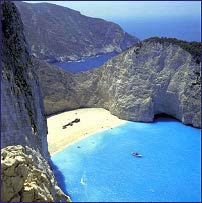
Situated only 21km west of the Peloponnesian coast is Zakynthos with its fine sand beaches, mysterious marine caves, and fragrant wild flowers. In the west of this volcanic island the land is mountainous and the coast rocky.You can also view Zakynthos property for sale if you are interested in houses and real estate in Zakynthos.
Loggerhead turtles come ashore to lay their eggs on the golden sand beaches of the huge Bay of Laganas. The famous Shipwreck Beach (Navagio) is an exquisite beach of translucent, turquoise water. As you sail to the northernmost tip of the island to Cape Skinari, you will glimpse a number of caves. After your boat passes under three stone arches you will reach the blue cave, where a most breathtaking spectacle awaits you.
KYTHIRA & ANTIKYTHIRA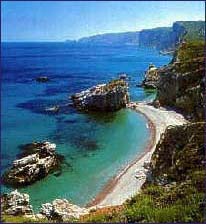
Located only 10 nautical miles from the Peloponnese, the quiet shores of Kythira, is an ideal destination for those seeking tranquility. It is a romantic place with mist-covered moors, twisting stone walled alleys and hidden valleys. There are more than forty villages spread evenly across the island.
The island's pretty capital Hora is situated along a steep cliff, 300m above the picturesque village of Kapsali. Kapsali's restaurant and cafe lined waterfront is set on two sandy bays. Its turquoise waters are enticing, it is a perfect spot to anchor and have a swim.
There are several charming and attractive villages to visit, such as the luxuriant, Karavas and lovely Avlemonas, via Paleopoli with its wide pebbled beach. Other good beaches include Kaladi Beach and Fyri Ammmos.
ANTIKYTHIRA
The little island of Antikythira is the most isolated, of the Ionian group, it is located 38km south of Kythira, with a population of 70. It has only one settlement, Potamos, one doctor and one teacher.
DODECANESE ISLANDS
View Regional Marine Chart & Map -- Top of PageRhodos, Karpathos, Kastellorizo, Tilos, Nisyros, Astypalea, Symi, Kos, Leros, Patmos, Lipsi
The remotest of the Greek archipelagos the Dodecanese was only incorporated into modern Greece in 1948, after 500 years of occupation by the Latin Knights of St John, the Ottomans, the Italians, the Germans and the British. Through it all the islanders have retained their Greek cultural identity.
The islands' history has left a legacy of rich and diverse archeological remains.
Members of the Dodecanese display a marked schizophrenia. Dry limestone outcrops such as Kalymnos, Symi and Kastellorizo attract those in pursuit of the traditional island life while the sprawling sandy giants of Rhodes and Kos have beaches and bars galore. Nisyros and Tilos are volcanic, while Astypalea and Patmos at the fringes resemble more the Cyclades.
This island group is renowned for its temperate climate and long tourist season.
RHODES
246 nautical miles from Piraeus
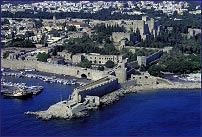 With an east coast of endless sandy beaches and sunshine 300 days a year, Rhodes is the most popular of the Dodecanese. It is also the largest, with a population of over 98,000. The luxuriant interior is beautiful. Tucked into the foothills of its mountains are charming villages. The incredibly well preserved old town of Rhodes is the largest inhabited medieval town in Europe. Behind imposing walls, it is the fortified nucleus of Rhodes City. The tranquil, twisting alleyways in the old town are a web of Byzantine, Turkish and Latin architecture. A fascinating sight to explore is the cobblestoned lanes and Gothic inns of the Knight's Quarter. With its old mosques and Turkish baths, the Hora has more of an Ottoman influence. The new town was once the site of the ancient Hellenistic city of Rhodes, today it is a lively entertainment center with over 600 discos and bars to choose from.
The brilliant white houses of Lindos with their pebbled mosaic courtyards date back to the 17th century. It will be a pleasure exploring the maze like alleyways of this beautiful village. The Acropolis of Lindos is the most famous of the Dodecanese's ancient cities. Dating back to 2000 BC, it is a mélange of Byzantine, Frankish and Turkish remains. It is strikingly set atop a rock 116m high. You can also view Rhodes property for sale if you are interested in houses and real estate in Rhodes.
With an east coast of endless sandy beaches and sunshine 300 days a year, Rhodes is the most popular of the Dodecanese. It is also the largest, with a population of over 98,000. The luxuriant interior is beautiful. Tucked into the foothills of its mountains are charming villages. The incredibly well preserved old town of Rhodes is the largest inhabited medieval town in Europe. Behind imposing walls, it is the fortified nucleus of Rhodes City. The tranquil, twisting alleyways in the old town are a web of Byzantine, Turkish and Latin architecture. A fascinating sight to explore is the cobblestoned lanes and Gothic inns of the Knight's Quarter. With its old mosques and Turkish baths, the Hora has more of an Ottoman influence. The new town was once the site of the ancient Hellenistic city of Rhodes, today it is a lively entertainment center with over 600 discos and bars to choose from.
The brilliant white houses of Lindos with their pebbled mosaic courtyards date back to the 17th century. It will be a pleasure exploring the maze like alleyways of this beautiful village. The Acropolis of Lindos is the most famous of the Dodecanese's ancient cities. Dating back to 2000 BC, it is a mélange of Byzantine, Frankish and Turkish remains. It is strikingly set atop a rock 116m high. You can also view Rhodes property for sale if you are interested in houses and real estate in Rhodes.
The butterfly covered gorge of Petaloudes is a must see.
You will find the best beaches on the east coast: Faliraki Beach is the island's premier resort; the beach at Kalithea Thermi is the site of an abandoned Italian spa.
If you are looking for quiet shores head to Stegna Beach or the sandy cove of Agathi.
KARPATHOS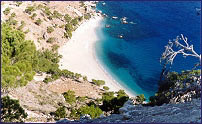 242 nautical miles from Piraeus
242 nautical miles from Piraeus
The unspoilt villages of mountainous Karpathos are rich in tradition, here the inhabitants have retained their local customs and ways. In the village of Olymbos (pop 340) the women dress in colorful, ornamental skirts, vests, headscarves, and goatskin boats. They still bake in outdoor communal ovens and grind corn in windmills. The inhabitants speak in a dialect containing some Doric words.
Clinging to slopes of Mt Kali Limni (1215m), the Dodecanese's second highest peak is the beautiful village of Pyles. With its spiraling steeped streets, pastel houses and citrus groves it is most definitely worth a visit.
The loveliest sand beaches are found on the east coast: Ahata, Kyra Panagia and Apella, which is exceptionally gorgeous with crystalline waters.
KASTELLORIZO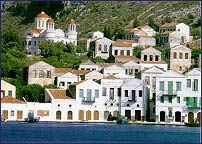
2.5km from the southern tip of Turkey
The tiny, remote island of Kastellorizo has a population of only 200, tourism here is very low key. There are no beaches, instead you will find several rocky inlets, where you can swim and snorkel in the crystalline sea. The only settlement is Kastellorizo Town, imposing three story mansions border the waterfront. With the Knights of St John Castle situated above the quay, it is one of the most picturesque harbors in the Dodecanese. On the southeastern coast of the island is the beautiful blue cave.
TILOS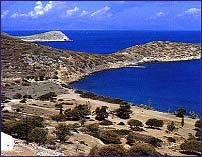 220 nautical miles from Piraeus
220 nautical miles from Piraeus
Isolated Tilos has fine tranquil beaches, vistas of high cliffs, rocky inlets and valleys of almond and walnut trees. For those seeking a relaxing, authentic Greek island feel, Tilos is it. There are only two settlements, the peaceful whitewashed village of Magalo Horio and the waterfront town of Livadia. The uncrowded beaches of Eristos (shaded), Agios Antonis (sandy) and Plaka are a real treat after spending time at some of the popular beach resorts on Rhodes and Kos
NISYROS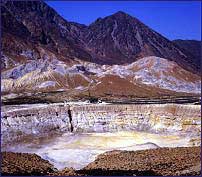 Nisyros is one of the most beautiful of all Greek islands, it is a strange combination of luxuriant vegetation and stark moonscapes. A dormant volcano lies at the center of the island. The charming port town of Mandraki is comprised of winding alleys and brightly colored houses. It is situated beneath the cliff top monastery, Moni Panagias Spilianis. Near the port you will find the black stoned beach of Koklaki.
Set on the volcano's ridge are the villages of Emboreios and Nikea, both have spectacular views into the caldera. With only 20 inhabitants, the spiraling, steeped streets of Emboreios are eerily empty. On the other hand the picturesque village of Nikea buzzes with life.
The islands best beaches are at Pali and Lies.
Nisyros is one of the most beautiful of all Greek islands, it is a strange combination of luxuriant vegetation and stark moonscapes. A dormant volcano lies at the center of the island. The charming port town of Mandraki is comprised of winding alleys and brightly colored houses. It is situated beneath the cliff top monastery, Moni Panagias Spilianis. Near the port you will find the black stoned beach of Koklaki.
Set on the volcano's ridge are the villages of Emboreios and Nikea, both have spectacular views into the caldera. With only 20 inhabitants, the spiraling, steeped streets of Emboreios are eerily empty. On the other hand the picturesque village of Nikea buzzes with life.
The islands best beaches are at Pali and Lies.
ASTYPALEA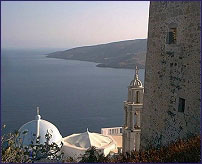 Astypalea, the most western of the Dodecanese, is more reminiscent of the Cylades. The picturesque hilltop village of Hora is comprised of narrow twisting streets and dazzling white cube houses with brightly colored wooden balconies and doors. Rising above the village is a Venetian fortress and a row of windmills.
The tiny resort of Livadia is situated in a fertile valley, its beach is the best on Astypalea.
Mesa Vathy and Exo Vathy are two cozy beach hamlets.
Across the laid back settlement of Maltezana are a number of uninhabited islets to explore.
Astypalea, the most western of the Dodecanese, is more reminiscent of the Cylades. The picturesque hilltop village of Hora is comprised of narrow twisting streets and dazzling white cube houses with brightly colored wooden balconies and doors. Rising above the village is a Venetian fortress and a row of windmills.
The tiny resort of Livadia is situated in a fertile valley, its beach is the best on Astypalea.
Mesa Vathy and Exo Vathy are two cozy beach hamlets.
Across the laid back settlement of Maltezana are a number of uninhabited islets to explore.
SYMI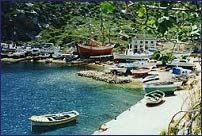 10km from the Turkish peninsula of Dorakis
10km from the Turkish peninsula of Dorakis
Symi's rugged interior is accented with cypress and pine forests. The small bays and pebbled beaches along the coast are indented with towering cliffs. Because of the mild climate, the season here lasts until late October. Symi Town is a Greek gem. Neoclassical mansions painted in a variety of colors ascend the steep hillside, surrounding the curved harbor.
Symi has a number of wonderful beaches, such as Nanous Beach and Agia Marina, both of which have a taverna, and Symi's only sand beach Agios Nikolaos. The beach at Georgiou Disalona Bay is set against a backdrop of towering cliffs.
The more remote Marathounta and Agios Emilianos beaches are only accessible by boat.
KOS
200 nautical miles from Piraeus
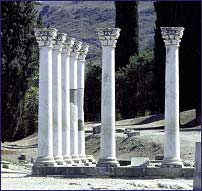 Situated only 5km off the Turkish peninsula of Bodrum, is Kos, one of the most fertile islands in the Dodecanese. Like Rhodes, it is abundant with ancient remains and beautiful beaches. The landscape of modern Kos Town, the island's capital and main port, is picturesque and luxuries. The Castle of the Knights prevails over the port, while Hellenistic and Roman ruins are littered everywhere. There are numerous archaeological sites to visit here.
The Asclepion is Kos' most important ancient site, it is located on a pine covered hill 4km southwest of Kos Town. Until 554 AD people came from far and wide to be treated at its healing center, there was also a school of medicine where the teachings of Hippocrates was followed.
Situated only 5km off the Turkish peninsula of Bodrum, is Kos, one of the most fertile islands in the Dodecanese. Like Rhodes, it is abundant with ancient remains and beautiful beaches. The landscape of modern Kos Town, the island's capital and main port, is picturesque and luxuries. The Castle of the Knights prevails over the port, while Hellenistic and Roman ruins are littered everywhere. There are numerous archaeological sites to visit here.
The Asclepion is Kos' most important ancient site, it is located on a pine covered hill 4km southwest of Kos Town. Until 554 AD people came from far and wide to be treated at its healing center, there was also a school of medicine where the teachings of Hippocrates was followed.
There are several lovely unspoilt villages spread across the northern slopes of the green and forested Dikeos mountain range, such as the pristine hamlets of Agios Georgios and Agios Dimitrios.
Amongst the many sandy beaches, Agios Stefanos set next to the ruins of two 5th century basilicas, is a must. At Masthari you can find a number of secluded spots on its sandy shores.
LEROS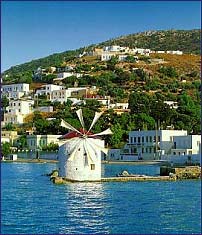 Leros' gentle, slopping countryside is spotted with smallholdings and huge, impressive, almost-landlocked bays, resembling lakes more than open sea. Platanos, the capital of Leros is 3km north of Lakki, the main port. This tiny picturesque village spills down the slender hillside to the port of Agios Marina. On the east side of Platanos, the mountainside dwellings are crowned by a massive castle.
Leros' gentle, slopping countryside is spotted with smallholdings and huge, impressive, almost-landlocked bays, resembling lakes more than open sea. Platanos, the capital of Leros is 3km north of Lakki, the main port. This tiny picturesque village spills down the slender hillside to the port of Agios Marina. On the east side of Platanos, the mountainside dwellings are crowned by a massive castle.
Set on the wide Alinda Bay, are the adjoining resorts of Krithoni and Alinda, which has a lovely, long tree-shaded sand beach.
At Belfoutis Bay you will find a shaded sand and pebble beach and a good taverna.
A good spot for snorkeling, Xirokambos Bay is a mellow resort with a sand beach.
PATMOS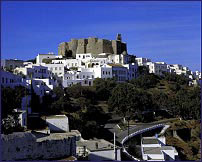 For both Orthodox and Western Christians, Patmos has long been a place of pilgrimage, for it was here that St John wrote his divinely inspired revelation, the Apocalypse. Once a favorite destination for the devout, Patmos is now just as popular with sun and sea worshippers. All boats dock at glitzy Skala, which sprawls around a large curving bay. Wrapped around the immense Monastery of St John the Theologian, the beautiful hilltop village, Hora. With its immaculate whitewashed houses and maze like alleys, it is absolutely enchanting. A tour of the monastery and of the cave where John received his divine revelations, the Monastery of the Apocalypse, is a must.You can also view Patmos property for sale if you are interested in houses and real estate in Patmos.
For both Orthodox and Western Christians, Patmos has long been a place of pilgrimage, for it was here that St John wrote his divinely inspired revelation, the Apocalypse. Once a favorite destination for the devout, Patmos is now just as popular with sun and sea worshippers. All boats dock at glitzy Skala, which sprawls around a large curving bay. Wrapped around the immense Monastery of St John the Theologian, the beautiful hilltop village, Hora. With its immaculate whitewashed houses and maze like alleys, it is absolutely enchanting. A tour of the monastery and of the cave where John received his divine revelations, the Monastery of the Apocalypse, is a must.You can also view Patmos property for sale if you are interested in houses and real estate in Patmos.
There are a number of sandy tree-shaded beaches around the island. Psili Ammos is the islands best beach, it is only accessible by boat.
LIPSI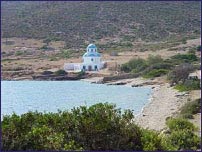 Lipsi is a delightful little island with good beaches. The picturesque port town of Lipsi is the only settlement. The countryside is dotted with olive groves and cypresses. Lipsi produces a strong wine known as Lipsi Black.
The island's main attraction, are its beaches, such as Platys Gialos a lovely sandy beach with a good taverna and the pebbled beach of Monodendri (nudist), set on a rocky peninsula.
Lipsi is a delightful little island with good beaches. The picturesque port town of Lipsi is the only settlement. The countryside is dotted with olive groves and cypresses. Lipsi produces a strong wine known as Lipsi Black.
The island's main attraction, are its beaches, such as Platys Gialos a lovely sandy beach with a good taverna and the pebbled beach of Monodendri (nudist), set on a rocky peninsula.
N. EASTERN AEGEAN ISLANDS
View Regional Marine Chart & Map -- Top of PageSamos, Ikaria, Chios, Inousses, Lesvos (Mytilini), Limnos, Samothraki, Thasos
Mountainous, green and carpeted with forests they are ideal for hiking but most are endowed with long stretches of delightful beaches. These islands are less visited than either the Dodecanese or the Cyclades, ideal for those seeking a more low-key vacation destination. Apart form Thasos and Samothraki they are much closer to Turkey than to the Greek mainland, the Anatolian legacy still lingers, especially in the architecture.
SAMOS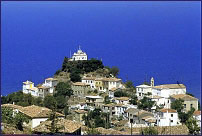 Samos is the closest of all the Greek islands to Turkey, from which it is separated by the 3km-wide Mykale Straits. Visits into its interior are rewarded with unspoilt villages and mountain vistas. In summer the humid air is intoxicating with heavy floral scents, especially jasmin. This, and the impressive greenery of the landscape, lends Samos an exotic, tropical air. Orchids are grown here for export and a most exceptional wine is made from the local grapes.
Samos is the closest of all the Greek islands to Turkey, from which it is separated by the 3km-wide Mykale Straits. Visits into its interior are rewarded with unspoilt villages and mountain vistas. In summer the humid air is intoxicating with heavy floral scents, especially jasmin. This, and the impressive greenery of the landscape, lends Samos an exotic, tropical air. Orchids are grown here for export and a most exceptional wine is made from the local grapes.
The island's capital is the large and bustling Samos Town (Vathy). Perched on the hillside surrounding the bay, 19th century red-tiled houses cascade down the hillside from charming Ano Vathy. You can also view Samos property for sale if you are interested in houses and real estate in Samos.
The resort town of Pythagoria is a convenient base from which to visit the ancient sites of Samos, such as the 1034m long Evpalinos Tunnel (524 BC). There is also a fascinating museum of paleontology.
On the lower slopes of Mt Ampelos through thick pine forests, you will find the beautiful village of Manolates, its old stone houses. The narrow lanes and squares are decorated with whitewashed floral designs.
There are numerous secluded beaches to explore around the island.
IKARIA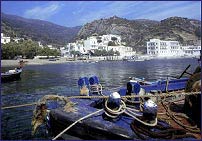 Ikaria is a rugged mountainous island, abundant with cypress trees, pine forests, olive and fruit trees. At present, tourism is low-key, but it is slowly being discovered. Ikaria's beaches at Livadi and Meshati, near Armenistis have to be rated as among the best in Greece. Its therapeutic radioactive springs are believed to be the most effective in Europe. Agios Kirykos, the capital, is a pleasant, relaxed little town with several kafenia along a tree-shaded waterfront. Sailing along the northeast coast to the Cape of Drakano, you will discover a number of exquisite, secluded coves and beaches.
Ikaria is a rugged mountainous island, abundant with cypress trees, pine forests, olive and fruit trees. At present, tourism is low-key, but it is slowly being discovered. Ikaria's beaches at Livadi and Meshati, near Armenistis have to be rated as among the best in Greece. Its therapeutic radioactive springs are believed to be the most effective in Europe. Agios Kirykos, the capital, is a pleasant, relaxed little town with several kafenia along a tree-shaded waterfront. Sailing along the northeast coast to the Cape of Drakano, you will discover a number of exquisite, secluded coves and beaches.
Armenistis is 15km west of the island's second port Evdilos. Armenistis is Ikaria's largest resort with two beautiful long beaches of pale golden sand. It is also a good base for exploring some of the quirky, laid back mountain villages.
Lying between Ikaria and Samos is the tiny, mountainous island of Fourni.
It is ideal for those seeking a quiet retreat, a number of good beaches dot the coast.
CHIOS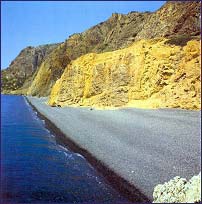 Chios is a large island spanning 859 sq km. It is separated from the Turkish Karaburum Peninsula by only 8km. Southern Chios is mainly made up of medieval villages that were built by the Genoese colonizers in the 14th century. Here the hills are overrun with mastic trees that were the main income for these settlements, hence the name Mastihoria (mastic villages).
Chios is a large island spanning 859 sq km. It is separated from the Turkish Karaburum Peninsula by only 8km. Southern Chios is mainly made up of medieval villages that were built by the Genoese colonizers in the 14th century. Here the hills are overrun with mastic trees that were the main income for these settlements, hence the name Mastihoria (mastic villages).
The largest of the Mastihoria is Pyrgi, one of the most extraordinary villages in the whole of Greece. The arch covered streets of this fortified village are narrow and maze like. The building facades are decorated with intricate gray and white designs. The patterns are rich in variation, some are geometric and others are floral, leaf, and animal.
For those looking to relax head to Emboreios, a quiet holiday resort. The beach here Mavra Voila Beach has black volcanic pebbles.
INOUSSES
Off the northeast coast of Chios you will find a cluster of nine tiny islets, known as Inousses. Only one of these, also called Inousses is inhabited. It may be small but it is the ancestral home of a number of exceedingly wealthy Greek ship owners, consequently there are some luxurious mansions. Tourism here is very low-key. The island has one settlement, the charming little village Inousses Town. It has but a couple of good tavernas and a waterfront bar. There are several lovely beaches and coves around the island.
LESVOS (MYTILINI)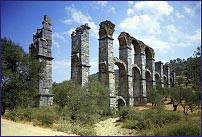 Lesvos is the third largest island after Crete and Evia. The south and east of the island is fertile, with numerous olive groves. In contrast the west has a rocky and barren mountainous terrain. Lesvos has an impressively well-organized set of trekking trails in the north and south of the island. Bird watching is also another popular activity on Lesvos. There are a number of museums to visit in the capital port town of Mytilini, which also boasts a lively nightlife.
Lesvos is the third largest island after Crete and Evia. The south and east of the island is fertile, with numerous olive groves. In contrast the west has a rocky and barren mountainous terrain. Lesvos has an impressively well-organized set of trekking trails in the north and south of the island. Bird watching is also another popular activity on Lesvos. There are a number of museums to visit in the capital port town of Mytilini, which also boasts a lively nightlife.
To the north you will find beautiful Molyvos. Its impeccable stone houses reach down to the harbor from a castle crowned hill and the winding, cobbled stone streets are shaded by vines. There are some lovely tavernas at the far end of the harbor.
A few kilometers beyond the traditional inland village of Eresos is Skala Eresou, a popular beach resort. Although it gets crowded it has a good laid back atmosphere. It is here you will find the loveliest stretch of beach in Lesvos. Nearby you can visit the petrified forest, which some experts estimate to be 20 million years old.
LIMNOS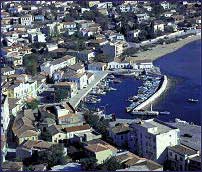 The island of Limnos is practically severed in two by Moudros Bay. Made up of quaint little farms, Limnos has a unique and subdued appeal. In spring brightly colored wild flowers dot the landscape, and in autumn purple crocuses bloom forth. Large numbers of flamingos wade along the lake of eastern Limnos and the coastline is graced with some of the best beaches in the North-Eastern Aegean. You will not find mass tourism here. Surrounded by massive, volcanic rocks is the capital and port town of Myrina. A Genoeses castle towers dramatically over the town. There is a lovely sand beach right in town.
The island of Limnos is practically severed in two by Moudros Bay. Made up of quaint little farms, Limnos has a unique and subdued appeal. In spring brightly colored wild flowers dot the landscape, and in autumn purple crocuses bloom forth. Large numbers of flamingos wade along the lake of eastern Limnos and the coastline is graced with some of the best beaches in the North-Eastern Aegean. You will not find mass tourism here. Surrounded by massive, volcanic rocks is the capital and port town of Myrina. A Genoeses castle towers dramatically over the town. There is a lovely sand beach right in town.
The road to the northern tip of the island is worth exploring, there are some traditional Limnian villages and the often-deserted beach at Keros, is popular with windsurfers.
SAMOTHRAKI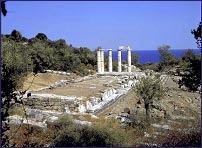 Located 32km from Alexandroupolis, the island of Samothraki, scenically is one of the most awe inspiring of all Greek islands. It may be a small island but it is endowed with a most diverse and dramatic landscape. Below the mighty peak of Mt Fengari (1611m) you will find valleys of huge twisting oaks, thick forests, and wet shaded glades where waterfalls cascade into deep, icy pools. On the gentler western slopes there are corn fields dotted with wild flowers. You will be pleased to learn Samothraki does not have package tourism. Hora concealed in a fold of the mountains above the port of Kamariotissa, is one of the most spectacular of Greek island villages. The crumbling red tiled houses are stacked up two neighboring mountainsides. The village is totally authentic; there is no yielding to tourism here. The ruined castle at the top of the main thoroughfare is fascinating to explore.
The massive site of the Sanctuary of the Great Gods, is a must see, it is one of the most enchanting in the whole of Greece.
Located 32km from Alexandroupolis, the island of Samothraki, scenically is one of the most awe inspiring of all Greek islands. It may be a small island but it is endowed with a most diverse and dramatic landscape. Below the mighty peak of Mt Fengari (1611m) you will find valleys of huge twisting oaks, thick forests, and wet shaded glades where waterfalls cascade into deep, icy pools. On the gentler western slopes there are corn fields dotted with wild flowers. You will be pleased to learn Samothraki does not have package tourism. Hora concealed in a fold of the mountains above the port of Kamariotissa, is one of the most spectacular of Greek island villages. The crumbling red tiled houses are stacked up two neighboring mountainsides. The village is totally authentic; there is no yielding to tourism here. The ruined castle at the top of the main thoroughfare is fascinating to explore.
The massive site of the Sanctuary of the Great Gods, is a must see, it is one of the most enchanting in the whole of Greece.
You should not miss the walk along the Fonias River to the Vathres rock pools; the water is pretty icy but a real treat on a hot day.
THASOS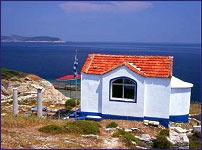 The main draw to Thasos are its excellent beaches and the many archaeological remains in and around the capital of Limenas, which is built on top of the ancient city, ruins are scattered all over the place.
The adjacent villages of Panagia and Potamia are quite lively and picturesque.
The long sandy Golden Beach is the islands best.
The main draw to Thasos are its excellent beaches and the many archaeological remains in and around the capital of Limenas, which is built on top of the ancient city, ruins are scattered all over the place.
The adjacent villages of Panagia and Potamia are quite lively and picturesque.
The long sandy Golden Beach is the islands best.
The west coast consists of a series of seaside villages, the least touristy is the delightful fishing village Skala Marion. Between here the lively resort town of Limenaria, lies a stretch of uncrowded beaches.
CRETE View Regional Marine Chart & Map -- Top of Page
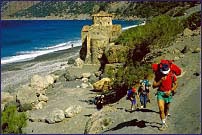
Crete is the largest and southernmost island in Greece, it possesses some of the most striking wilderness. A massive mountain range spans from east to west, across the island. The mountains are peppered with a lush landscape, and indented with numerous rugged gorges. Long and sandy beaches dot the coastline. Both terrain and inhabitants assume larger than life proportions, its not uncommon to see a Cretan patriarch all decked out in tsalvaria (baggy pants), high boots, vest, leather apron and sakri (headband) sitting in the local kafenio, sipping tsikudhia.
The island was the site of Europe's first advanced civilization, the Minoan. The archaeological remains are amongst the most impressive in Europe. Iraklio is Crete's humming capital. The areas major attractions are the ancient Minoan cities of Knossos, Malia and Phaestos, each site requires several hours to explore. The archaeological museum in town is outstanding. You can also view Crete property for sale if you are interested in houses and real estate in Crete.
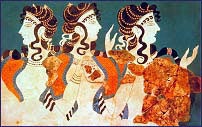 To the west lie the spectacular Samaria Gorge and the beautiful old Venetian cities of Hania and Rethymno. Also located in this region are the island's premier beaches. The passage of the majestic gorge of Samaria is certainly the single most popular walking tour on the whole island, and possibly in all of Greece. At over 18km in length, the gorge is the longest in Europe. Its width varies from 150m to 3m and its vertical walls reach 500m at their highest point.
To the west lie the spectacular Samaria Gorge and the beautiful old Venetian cities of Hania and Rethymno. Also located in this region are the island's premier beaches. The passage of the majestic gorge of Samaria is certainly the single most popular walking tour on the whole island, and possibly in all of Greece. At over 18km in length, the gorge is the longest in Europe. Its width varies from 150m to 3m and its vertical walls reach 500m at their highest point.
The old Venetian-Ottoman quarter of Rethymno is a labyrinth of threadlike streets, wood-balconied homes, splendid Venetian monuments and numerous minarets.
There is a beach located right in the town, and a lively nightlife to boast.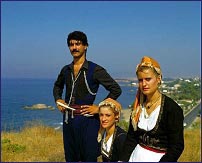 Much money has been invested in the restoration of the beautiful, crumbling Venetian quarter in Hania. As a result many of old buildings have been converted into chic restaurants, bars and shops. Hania's covered food market is magnificent. Don't miss an opportunity to swim in the translucent waters of Sweet Water Beach (fresh spring water seeps from the rocks) or the long sandy beach located in the little town of Paleohora. In the evening the main street is closed to traffic and the tavernas expand on to the road.
Elafonisi is one of the loveliest sand beaches in Crete. From here you can wade across 50m of sea to the low-lying dunes of Elafonisi Islet.
Much money has been invested in the restoration of the beautiful, crumbling Venetian quarter in Hania. As a result many of old buildings have been converted into chic restaurants, bars and shops. Hania's covered food market is magnificent. Don't miss an opportunity to swim in the translucent waters of Sweet Water Beach (fresh spring water seeps from the rocks) or the long sandy beach located in the little town of Paleohora. In the evening the main street is closed to traffic and the tavernas expand on to the road.
Elafonisi is one of the loveliest sand beaches in Crete. From here you can wade across 50m of sea to the low-lying dunes of Elafonisi Islet.
The Lassithi Plateau is one of the main attractions in the eastern quarter of the island. Located 900m above sea level, it is a sprawling expanse of orchards and forests, dotted by some 7000 windmills, which date back to the 17th century. There are over 20 villages to visit in this area. An exploration of the Dikteon Cave will prove quite fascinating.
THE PELOPONNESE
View Regional Marine Chart & Map -- Top of PageArgolis, Arcadia, Lakonia, Mani, Messinia, Elia
The Peloponnese misses being an island by only six km, the width of the Isthmus of Corinth, connecting it to the rest of mainland Greece. Cut through the solid rock of the isthmus is the Corinth Canal. Constructed in the 19th century, it links the Ionian and the Aegean seas. It has a depth of 8m and a surface width of 24m. The waters travel to speeds of up to 3 miles per hour, changing direction every 6 hours (when it does so the current comes to a stand still). With vertical sides rising 90m above the water, it is an impressive sight. Archaic ruins and medieval monuments are more abundant here than anywhere else in the country: Venetian and Frankish fortresses, Byzantine cities and ancient Greek sites. It's a location of phenomenal and diverse beauty with towering snow-capped mountains, orchards and river valleys, fine beaches, and near desert.
ARGOLIS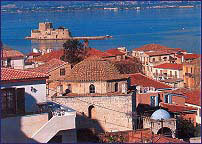 Separating the Saronic and Argolic gulfs is the Argolis Peninsula. Nafplio and the ancient cities of Mycenae, Tiryns, Argos and Epidaurus are the region's main attractions.
Located on the Argolic Gulf, Nafplio is one of Greece's loveliest towns. The threadlike streets of the old town are lined with refined Venetian homes and elegant neoclassic mansions. Three Venetian fortresses dominate the town: the sprawling fortress of Palamadi, which towers over the town, the small island fortress of Bourtzi, and the oldest, Akronafplia.
Separating the Saronic and Argolic gulfs is the Argolis Peninsula. Nafplio and the ancient cities of Mycenae, Tiryns, Argos and Epidaurus are the region's main attractions.
Located on the Argolic Gulf, Nafplio is one of Greece's loveliest towns. The threadlike streets of the old town are lined with refined Venetian homes and elegant neoclassic mansions. Three Venetian fortresses dominate the town: the sprawling fortress of Palamadi, which towers over the town, the small island fortress of Bourtzi, and the oldest, Akronafplia.
There are a number of fine restaurants in the old town and a lively nightlife with numerous bars to choose from.
There's a succession of good sandy beaches along the coast to the east of Nafplio.
Situated 30km east of Nafplio is Epidaurus, one of the most famous of Greece's ancient sites. The place was a religious center and a fashionable spa. In addition to the temples and colonnades devoted to Asklepios, there were hospitals, sanatoria, hotels, and baths. The Theatre, the best preserved of all Greek theatres, dates from 4C BC. It is now celebrated as the center of an annual summer festival of music and drama.
ARCADIA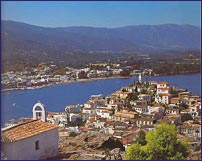 The lovely pastoral prefecture of Arcadia is mainly located in the central Peloponnese. In this remote region you will discover medieval villages, isolated monasteries and Frankish castles. Enswathed by lush mountains, running streams and shaded valleys, Arcadi also has about 100km of unspoilt coastline on the Argolic Gulf, stretching from the pretty town of Myli to Leonidio (dramatically located at the mouth of the Badron Gorge). The beaches here are excellent. Beneath the slopes of the Menalon Mountains you can explore a web of medieval villages. This region is high above sea level, so the nights can get quite chilly.
The lovely pastoral prefecture of Arcadia is mainly located in the central Peloponnese. In this remote region you will discover medieval villages, isolated monasteries and Frankish castles. Enswathed by lush mountains, running streams and shaded valleys, Arcadi also has about 100km of unspoilt coastline on the Argolic Gulf, stretching from the pretty town of Myli to Leonidio (dramatically located at the mouth of the Badron Gorge). The beaches here are excellent. Beneath the slopes of the Menalon Mountains you can explore a web of medieval villages. This region is high above sea level, so the nights can get quite chilly.
LAKONIA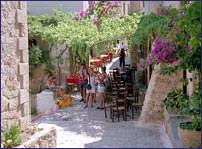 Amongst the main attractions in Lakonia are the splendid Byzantine churches and monasteries at Mystras, to the west, and the medieval town of Monemvasia in the southeast.
Mystra a purely medieval town in its ruin, should on no account be missed. Churches, monasteries, palaces and houses line the narrow winding streets. Within the walls of this enchanting site are some of the finest examples of Byzantine architecture in Greece. An impregnable fortress crowns the summit. One needs a full day to explore.
Often referred to as the Gibraltar of Greece, Monemvasia is an imposing rock, towering dramatically out of the sea. Inaccessible to cars and motorcycles, it can be reached by a causeway from the mainland village of Gefyra. Behind its massive fortifying walls is a magical, medieval town of stone houses, narrow cobbled streets and spiraling staircases.
Amongst the main attractions in Lakonia are the splendid Byzantine churches and monasteries at Mystras, to the west, and the medieval town of Monemvasia in the southeast.
Mystra a purely medieval town in its ruin, should on no account be missed. Churches, monasteries, palaces and houses line the narrow winding streets. Within the walls of this enchanting site are some of the finest examples of Byzantine architecture in Greece. An impregnable fortress crowns the summit. One needs a full day to explore.
Often referred to as the Gibraltar of Greece, Monemvasia is an imposing rock, towering dramatically out of the sea. Inaccessible to cars and motorcycles, it can be reached by a causeway from the mainland village of Gefyra. Behind its massive fortifying walls is a magical, medieval town of stone houses, narrow cobbled streets and spiraling staircases.
MANI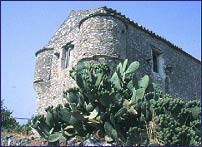 This area encompasses the central peninsula in the south of the Peloponnese. It is famous for its historic tower settlements, erected as refuges from the clan wars, starting in the 17th century onwards. The rocky, barren mountains of inner Mani (Lakonian Mani) blessed with a profusion of wild flowers on its lower slopes. Its steep cliffs plunge into the sea. It is mainly here, you will find the imposing stone towers, restoration of these austere buildings is increasing.
The rugged coast of Messinian Mani is dotted with numerous small coves and beaches, backed by mountains that remain snow-crested until late may.
This area encompasses the central peninsula in the south of the Peloponnese. It is famous for its historic tower settlements, erected as refuges from the clan wars, starting in the 17th century onwards. The rocky, barren mountains of inner Mani (Lakonian Mani) blessed with a profusion of wild flowers on its lower slopes. Its steep cliffs plunge into the sea. It is mainly here, you will find the imposing stone towers, restoration of these austere buildings is increasing.
The rugged coast of Messinian Mani is dotted with numerous small coves and beaches, backed by mountains that remain snow-crested until late may.
MESSINIA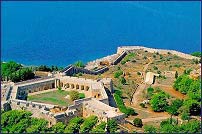 Located on the southwestern corner of the Peloponnese, Messinia is the least visited of the regions, which is surprising. Finikounda has a string of some of the best beaches in the country, and the Venetian towns of Koroni and Methoni are lovely, unspoilt hidden spots.
Located on the southwestern corner of the Peloponnese, Messinia is the least visited of the regions, which is surprising. Finikounda has a string of some of the best beaches in the country, and the Venetian towns of Koroni and Methoni are lovely, unspoilt hidden spots.
Located on the coast Methoni is a lovely town, with a spectacular 15th century Venetian fortress, and a stretch of sand beach. The sprawling fortress is separated from the mainland by a moat. It is easy to spend half a day here exploring the buildings, baths and underground passages. There is also Bourtzi castle nearby to visit.
Koroni's main attraction is Zaga Beach, a long stretch of golden sand.
ELIA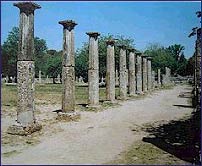 Most come to this agriculturally rich region for one reason, to visit Ancient Olympia.
Situated in a beautiful valley, the setting, in great contrast with most Greek sites, is pastoral, green, and lush. Olympia was a sacred precinct occupied exclusively by temples, dwellings for the priests and officials, and public buildings in connection with the games. It was also a sanctuary of Greek treasures. The Games were held regularly here for over a 1000 years, starting from 776BC. This World Heritage listed site is not to be missed.
Most come to this agriculturally rich region for one reason, to visit Ancient Olympia.
Situated in a beautiful valley, the setting, in great contrast with most Greek sites, is pastoral, green, and lush. Olympia was a sacred precinct occupied exclusively by temples, dwellings for the priests and officials, and public buildings in connection with the games. It was also a sanctuary of Greek treasures. The Games were held regularly here for over a 1000 years, starting from 776BC. This World Heritage listed site is not to be missed.
STEREA ELLADA
Epiros and Thessaly flank Sterea Ellada to the north and the narrow gulfs of Corinth and Patras in the south. To the east, separated from the mainland by a narrow gulf is the large island of Evia.
In this region the landscapes varies greatly: barren rocky outcrops, lush mountains, and flat wetlands.
One of the main attractions in this area is the oracle of Delphi. Situated on the slopes of Mt Parnassos, and towering over the Gulf of Corinth, Delphi stretches into a valley of olive and cypress trees. It is in this stunning location the ancient Greeks choose to erect the Sanctuary of Apollo. Scores of pilgrims bearing gifts came to ask advice of the Delphic oracle, believed to be the mouthpiece of Apollo. There are a number of spectacular ruins to explore on this World Heritage listed site. The museum houses the numerous amassed treasures.
Located near Delphi is Galaxidi, the loveliest of a series of laid-back resorts. This pretty harbor town is backed by towering mountains and bordered by a string of pebbled beaches.
ATHENS View Regional Marine Chart & Map -- Top of Page
Since the Age of Pericles the Acropolis has dominated the Athenian skyline, it is an ancient backdrop to this modern, cosmopolitan city. The bustling city of Athens is crammed with shops, lively tavernas, bars, historic landmarks, and cafes, where you can take refuge from the mid-day sun and enjoy a frappe (ice-coffee). The chic district of Kolonaki has dozens of trendy cafes and boutiques. Nestled beneath Lykavitos Hill, it is "the" place in Athens to sip coffee and people-watch.
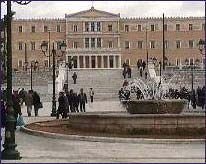 There are hundreds of inexpensive eateries serving up dishes of hearty Greek cuisine. Often the little holes-in-the-wall with a simple grill and rickety tables are the best, but if you are looking for something more upscale, Athens' has it. Some delicious dishes worth sampling are moussaka (layers of eggplant, minced meat and potatoes topped with cheese sauce and baked), yemista (stuffed tomatoes or peppers), soutzokakia (spicey meatballs in tomato sauce), and melizanes papoutsakia (baked eggplant, stuffed with meat and tomatoes and topped with cheese). You can also pass the evening at an ouzeri in the old Turkish quarter of Plaka, nibbling on small plates of mezedhes (appetizers) and sipping ouzo under the Acropolis.
There are hundreds of inexpensive eateries serving up dishes of hearty Greek cuisine. Often the little holes-in-the-wall with a simple grill and rickety tables are the best, but if you are looking for something more upscale, Athens' has it. Some delicious dishes worth sampling are moussaka (layers of eggplant, minced meat and potatoes topped with cheese sauce and baked), yemista (stuffed tomatoes or peppers), soutzokakia (spicey meatballs in tomato sauce), and melizanes papoutsakia (baked eggplant, stuffed with meat and tomatoes and topped with cheese). You can also pass the evening at an ouzeri in the old Turkish quarter of Plaka, nibbling on small plates of mezedhes (appetizers) and sipping ouzo under the Acropolis.
The nightlife does not end till the break of dawn. There is a multitude of hip seaside clubs. Wandering around the famous flea market of Monastiraki will prove absolutely delightful. The whole area is littered with ancient ruins. There are several good museums in Athens, but the nations finest is the National Archaeological Museum. Opened since 1874, it has the world's greatest collection of Greek antiquities. You can also view Athens property for sale if you are interested in houses and real estate in Athens.
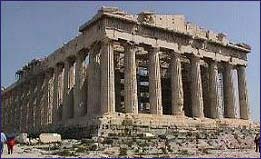 A stay in Athens would not be complete without a visit to the Acropolis. Towering over the winding alleyways of Plaka and Monastiraki, it is unsurpassable in grandeur, beauty and historic importance. The Parthenon is a particularly awesome sight in the setting sun and by the light of the full moon. It was the original city and dwellings of the early Kings and their court. Pericles spared no expense, only the best materials, architects, sculptors and artists were good enough for this city dedicated to the goddess Athena. Amongst the four surviving monuments is a museum, which houses a collection of sculptures and reliefs from the site. The Theatre of Herodes Atticus, on the slopes below the Acropolis, host's dance, drama and music performances throughout the summer.
A stay in Athens would not be complete without a visit to the Acropolis. Towering over the winding alleyways of Plaka and Monastiraki, it is unsurpassable in grandeur, beauty and historic importance. The Parthenon is a particularly awesome sight in the setting sun and by the light of the full moon. It was the original city and dwellings of the early Kings and their court. Pericles spared no expense, only the best materials, architects, sculptors and artists were good enough for this city dedicated to the goddess Athena. Amongst the four surviving monuments is a museum, which houses a collection of sculptures and reliefs from the site. The Theatre of Herodes Atticus, on the slopes below the Acropolis, host's dance, drama and music performances throughout the summer.
South of Athens is Piraeus, the largest commercial port in Greece with boat connections to all the Greek islands. Continuing along the coast from Piraeus, there are several fine marinas: Marina Zea, charming Micro Limeno with a multitude of outdoor fish tavernas to choose from, Palio Faliro, Kalamki (the largest), Glyfada, and Vouliagmeni, where the rich dock their impressive yachts. In addition there is Lavrion, the newly constructed Olympic Marina, it is a jumping board to the Cyclades. All of these marinas are conveniently located only an hour from Eleftherios Venizelos Airport in Spata.
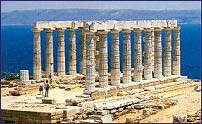 At the southeastern tip of Attica, 70km from Athens is Cape Sounion. It is here, 65m above the sea, where the Temple of Poseidon is located. Built in 444 BC, during the same time as the Parthenon, the temple is discernable from a great distance. It is a worthwhile excursion; the stretch of coastline from Athens is dotted with lovely beach resorts.
At the southeastern tip of Attica, 70km from Athens is Cape Sounion. It is here, 65m above the sea, where the Temple of Poseidon is located. Built in 444 BC, during the same time as the Parthenon, the temple is discernable from a great distance. It is a worthwhile excursion; the stretch of coastline from Athens is dotted with lovely beach resorts.
